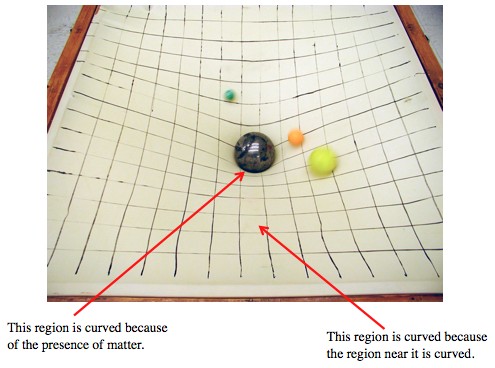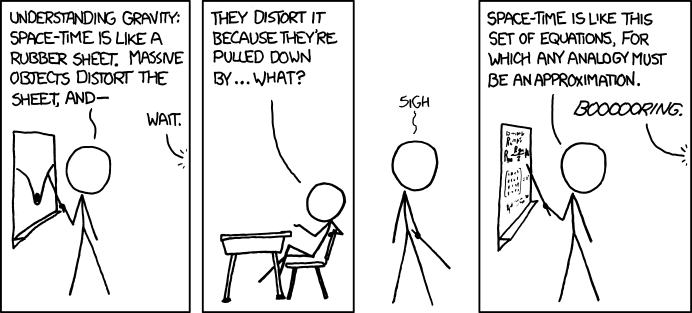Physicist: A black hole is usually described as a singularity, where all the mass is (or isn’t?), which is surrounded by an “event horizon”. The event horizon is the “altitude” at which the escape velocity is the speed of light, so nothing can escape. But if gravity is “emitted” by black holes, then how does that “gravity signal” get out? The short answer is that gravity isn’t “emitted” by matter. Instead, it’s a property of the spacetime near matter and energy.
It’s worth stepping back and considering where our understanding of black holes, and where all of our predictions about their behavior, comes from. Ultimately our understanding of black holes, as well as all of our predictions for their bizarre behavior, stems from the math we use to describe them. The extremely short answer to this question is: the math says nothing can escape, and that the gravity doesn’t “escape” so much as it “persists”. No problem.
Einstein’s whole thing was considering the results of experiments at face value. When test after test always showed the speed of light was exactly the same, regardless of how the experiment was moving, Einstein said “hey, what if the speed of light is always the same regardless of how you’re moving?”. Genius. There’s special relativity.
It also turns out that no experiment can tell the difference between floating motionless in deep space and accelerating under the pull of gravity (when you fall you’re weightless). Einstein’s stunning insight (paraphrased) was “dudes! What if there’s no difference between falling and floating?”. Amazing stuff.
Sarcasm aside, what was genuinely impressive was the effort it took to turn those singsong statements into useful math. After a decade of work, and buckets of differential geometry (needed to deal with messed up coordinate systems like the surface of Earth, or worse, curved spacetime) the “Einstein Field Equations” were eventually derived, and presumably named after Einstein’s inspiration: the infamous Professor Field.
This is technically 16 equations (μ and ν are indices that take on 4 values each), however there are tricks to get that down to a more sedate 6 equations.
The left side of this horrible mess describes the shape of spacetime and relates it to the right side, which describes the amount of matter and energy (doesn’t particularly matter which) present. This equation is based on two principles: “matter and energy make gravity… somehow” and “when you don’t feel a push or pull in any direction, then you’re moving in a straight line”. That push or pull is defined as what an accelerometer would measure. So satellites are not accelerating because they’re always in free-fall, whereas you are accelerating right now because if you hold an accelerometer it will read 9.8m/s2 (1 standard Earth gravity). Isn’t that weird? The path of a freely falling object (even an orbiting object) is a straight line through a non-flat spacetime.
Moving past the mind-bending weirdness; this equation, and all of the mathematical mechanisms of relativity, work perfectly for every prediction that we’ve been able to test. So experimental investigation has given General Relativity a ringing endorsement. It’s not used/taught/believed merely because it’s pretty, but because it works.
Importantly, the curvature described isn’t merely dependent on the presence of “stuff”, but on the curvature of the spacetime nearby. Instead of being emitted from some distant source, gravity is a property of the space you inhabit right now, right where you are. This is the important point that the “bowling ball on a sheet” demonstration is trying to get across.

The Einstein Field Equations describe the stretching of spacetime as being caused both by the presence of matter and also by the curvature of nearby spacetime. Gravity doesn’t “reach out” any more than the metal ball in the middle is.
So here’s the point. Gravity is just a question of the “shape” of spacetime. That’s affected by matter and energy, but it’s also affected by the shape of spacetime nearby. If you’re far away from a star (or anything else really) the gravity you experience doesn’t come directly that star, but from the patch of space you’re sitting in. It turns out that if that star gets smaller and keeps the same mass, that the shape of the space you’re in stays about the same (as long as you stay the same distance away, the density of an object isn’t relevant to its gravity). Even if that object collapses into a black hole, the gravity field around it stays about the same; the shape of the spacetime is stable and perfectly happy to stay the way it is, even when the matter that originally gave rise to it is doing goofy stuff like being a black hole.
This stuff is really difficult / nigh impossible to grok directly. All we’ve really got are the experiments and observations, which led to a couple simple statements, which led to some nasty math, which led to some surprising predictions (including those concerning black holes), which so far have held up to all of the observations of known black holes that we can do (which is difficult because they’re dark, tiny, and the closest is around 8,000 light years away, which is not walking-distance). That said: the math comes before understanding, and the math doesn’t come easy.
Here’s the bad news. In physics we’ve got lots of math, which is nice, but no math should really be trusted to predict reality without lots of tests and verification and experiment (ultimately that’s where physics comes from in the first place). Unfortunately no information ever escapes from beyond the event horizon. So while we’ve got lots of tests that can check the nature of gravity outside of the horizon (the gravity here on Earth behaves in the same way that gravity well above the horizon behaves), we have no way even in theory to investigate the interior of the event horizon. The existence of singularities, and what’s going on in those extreme scenarios in general, may be a mystery forever. Maybe.
This probably doesn’t need to be mentioned, but the comic is from xkcd.








Pingback: 19 Facts You Didn’t Know About Light | Display Lighting Blog